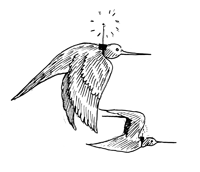STRANGE BUT TRUE- Non-stop flight: Could you fly for eight days?

DRAWING BY DEBORAH DERR McCLINTOCK
Q. What was all the excitement about in monitoring the recent flight of the female bar-tailed godwit from the bird's breeding ground in Alaska?—A. Hale
A. As reported in the Proceedings of the Royal Society B, she flew 11,680 kilometers (7,258 miles) nonstop to reach her winter home in New Zealand, going more than eight days without food, water, or rest, the longest direct flight of a bird ever documented, reported Laura Sanders in Science News.
"It's phenomenal that a bird can go that far," said Geoffrey Geupel of PRBO Conservation Science in Bolinas, California. A research team in Anchorage also tracked the flight of eight other godwits, whose monitors fell silent along the way but who were identified upon reaching their final destination.
Q. You Sudoku savants, could every person on Earth be given a different puzzle to work? –B. Nordin
A. There are 5,472,730,538 fundamentally distinct 9x9 Sudoku grids, less than the global population, says computer science professor Jean-Paul Delahaye. However, from each of these grids a vast number of others can be derived by various elementary operations, such as swapping two rows or columns or systematically replacing each number with some other (1 becomes 2, 2 becomes 7, and so on). The resulting number of different grids approaches 7 sextillion (7 followed by 21 zeros), enough for everyone everywhere to be given more than a trillion (12 zeros) personal puzzles!
The first Sudoku appeared in the May 1979 edition of Dell Pencil Puzzles and Word Games, under the title "Number Place." The puzzle jumped to a magazine in Japan in 1984, where it was eventually named "Sudoku" (single numbers). By late 2004, the London Times began publishing the puzzles, and from there they spread like wildfire, possibly enveloping you too in the heat.
Q. How long did it take for 1998 World Checkers Champion Ron "Suki" King of Barbados to play 385 games? –J. London
A. This spatial-intelligence genius did it in only 3 hours and 44 minutes by playing all 385 games at the same time, moving briskly from board to board, devoting only about 35 seconds to each game while his opponents could take hours to plot their moves, says David G. Myers in Psychology.
"Yet King still managed to win all 385 games!" Myers notes.
Q. No doubt you're already familiar with the "greenhouse effect" (warming of the Earth), the "butterfly effect" (small input, huge output), and the "Doppler effect" (changing pitch of a moving sound source). But how do these barely scratch the "effect" surface? –D. Stephenson
A. Scientists and technologists today have mainstreamed the term for naming all sorts of cultural things, says Paul McFedries in IEEE Spectrum magazine. Consider, for example, the "poverty effect" (a reduction in consumer spending due to a feeling of relative poverty as 401-Ks and the like lose value); the "lipstick effect" (consumers' tendency to purchase small comforting items rather than big luxury ones); the "Nascar" effect (displaying a large number of garish advertising logos on a Web site, T-shirt, etc.); the "iPod halo effect" (increased sales and perceived prestige of Apple products based on its popular iPod digital music player); and the "Gulliver effect" (a large target succumbing to an assault by numerous small adversaries).
Finally, says McFedries, my favorite is the "revenge effect," by the author of Why Things Bite Back, for the unintended and unwanted spinoffs of a new or modified technology— like the "effect effect."
~
Send Strange questions to brothers Bill and Rich at [email protected].
#